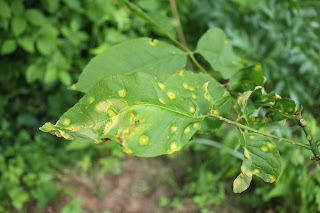The ash tree in my back yard was growing really well this year, and was over 6 feet tall. Then within a a week, it was covered with unsightly yellow lesions, and the leaves were curling.
I happened to see a post about the disease online, which led me to believe that the disease is incurable, and will ultimately lead to the death of the tree. So without doing any other research, I cut down the tree. Then I looked online, and found this info:
Although it is unsightly, ash rust is not a serious threat to the tree's health. Because of this, control measures are not usually necessary. Heavy infection may stress a young tree and make it more susceptible to winter injury. Cultural practices that reduce stress, such as watering during dry periods or mulching, can help to improve tree vigor.
The tree had been slowly growing there for about 4 years, but it took just 10 minutes to cut it down. What a lesson in patience, and in getting all the information before making an irreversible decision.









